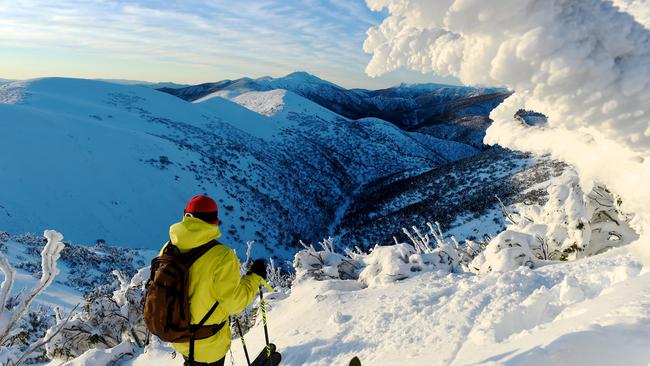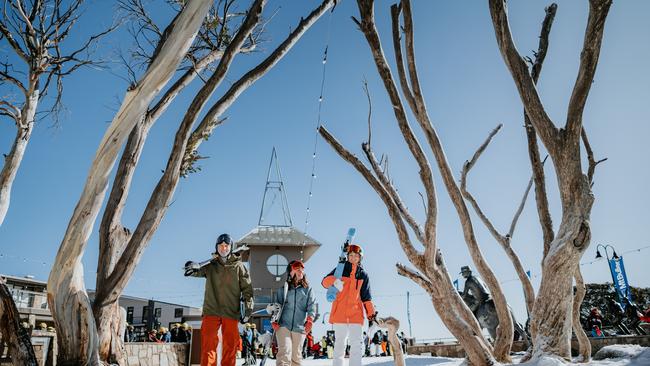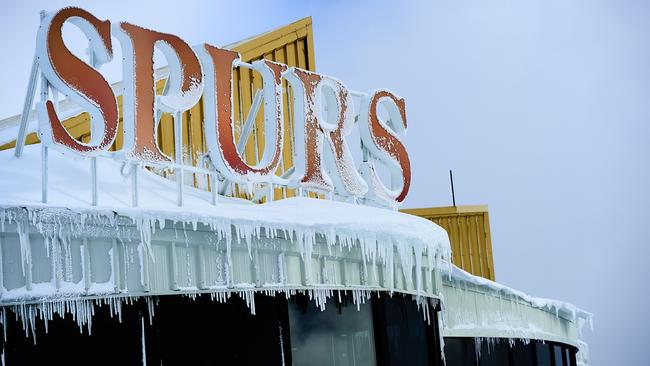What will the ski season be like this year?
With our snow fields opening, weather experts reveal what is in store — and what to do if it doesn’t snow.

The story goes that towards the end of the legendary ski season of 1981, when more than 3.5m of snow fell in some parts of the Australian Alps, a resort worker from Mt Hotham went to retrieve his car from a carpark on the mountain.
Unable to find it, he feared his vehicle had been stolen. It wasn’t until the snow melted a few weeks later that he found it exactly where it had been left. It had been so comprehensively buried by snow that other cars had parked on top.
In 1991, it snowed so much that groomers had to plough a path so Perisher’s Terminal chairlift could run, and even then riders’ dangling skis would skim the snow. The following year the snow was so good Mt Buller stayed open until Melbourne Cup weekend, and people were skiing off Mt Kosciuszko on Boxing Day.

Will we ever see those days again? Going on last season, you wouldn’t bet on it. Ski resorts tend to sugar-coat when nature doesn’t powder-coat, but there’s no getting around the fact that 2023 was a fizzer.
It was Australia’s warmest winter on record, and our worst snow season in 17 years, with a peak snow depth of 131cm recorded near Perisher, and just 56cm at Mt Buller. Every resort limped to an early close.
The outlook for the future isn’t promising, either. Modelling released this week byAustralian National University and Protect Our Winters Australia shows our ski seasons - already short compared with other countries - could shrink by up to 55 days by 2050 if greenhouse gas emissions aren’t drastically reduced.
POW director Sam Quirke says unless urgent measures are taken, seasons like 2023 will become the norm.
“We’ll see that happening more and more frequently, as seasons become more erratic and harder to predict due to global warming, until we do something about it.”
Despite all this, hopes are still high for a successful – and snowy - ski season, with weather boffins banking on short - term systems trumping long-term trends. Widespread snow is expected next week, but beyond that, forecasting snowfall gets tricky.

Seasonal clues come from studying climate drivers such as the ENSO cycle of water temperatures in the Pacific Ocean, meaning the oscillation between an El Nino phase (producing generally warmer and drier weather) and a La Nina phase (wetter and cooler).
The same oscillations occur in the Indian Ocean, but instead of using fancy Latin names we talk about a positive or negative Indian Ocean Dipole (IOD), with the negative phase generally more favourable for snowfall.
Then you have the Southern Annular Mode, which is the north-south movement of the strong westerly winds that blow between Australia and Antarctica, often associated with cold fronts.
The bad news is that none of these variables look particularly favourable for snowfall this season. “The season ahead is most likely going to be a below average season,” say Brett Dutschke, a meteorologist at Weatherzone.
“We’ve ceased El Nino and are now in an inactive phase, with a moderate chance of La Nina developing during winter. And we probably can’t rely on high amounts of moisture coming in from the Indian Ocean.”

But that’s not necessarily cause to lose hope. “Even when those climate drivers are not favourable you can still get a synoptic weather pattern that goes against climate,” says Dutschke. “You might get a week of really good cold fronts at the right time, and they can sometimes save a snow season. That’s what happened in 2018 and 2019.”
The website Mountainwatch is also lukewarm about snow prospects for this season, with its resident meteorologist “The Grasshopper” concerned about an emerging positive IOD, which often heralds drier winter weather. And even if a La Nina does develop, higher temperatures mean any associated moisture may fall as rain rather than snow. The Grasshopper says climate drivers “typically only account for about a quarter of snowfall variation - the rest is natural variability”.
Bureau of Meteorology senior climatology specialist Zhi-Weng Chua shares the view that snowfall is highly dependent on short-term weather events. The trend, though, is not good news. “Australia’s climate has warmed on average by 1.5C over the 1910-2023 period. Changes in snow cover are strongly linked to changes in air temperature.”
Chau says peak snow depths (as measured at Spencers Creek in the Snowy Mountains) have been decreasing by more than half a centimetre a year since 1954.
Such maximum snow depths are often the result of a single big dump, such as what occurred in 2014, when about 90cm of snow fell in less than a week, approximately half the average peak snow depth. But there are no observed trends in the frequency of those rare, heavy snowfall days.

Nor is there any correlation between early snowfall and overall quality or length of a ski season. Early snowfall is often a tease, as the ground is so warm that snow quickly melts if not regularly topped up. And it works the other way. In 2017 there wasn’t any natural snow on opening weekend at Mt Buller, yet it turned out to be the best season in years.
A good or bad season also has no bearing on what might happen next year. In 1992, Mt Buller nudged 190cm of snow in September. The following September saw barely a flake on the ground. Australia’s bumper season of 1981 was followed by a stinker. 1999 was a dud; 2000 was superb. 2006 claims the title of worst season on record, but the snow returned in a vengeance the following year.
And while last year was best forgotten, it pays to remember that the season before was very fine indeed, at higher elevations at least.
So what factors dictate whether the snow will arrive?
7News meteorologist Jane Bunn says forecasting for a mountain peak is one of the hardest jobs in meteorology: “In order to make snow you need three things to magically come together: a feed of moisture, instability and cold enough air. When we get the trifecta the results can be spectacular, but when it doesn’t line up it can be very frustrating.”

Bunn says that while we can’t predict the instability or cold air parts of the equation ahead of the season, we do have an idea about the moisture component.
“The temperatures of the oceans is one of the big predictors of how much moisture we’ll have to play with,” says Bunn. “An imbalance between warm and cool waters in the Indian and Pacific oceans influences the circulation of the air above it, and if this circulation spins in a favourable way then we have rivers of moisture that feed our weather systems.”
The challenge, then, is to get that river of moisture to line up with cold air and instability. A low from the east might be laden with moisture and instability, but without cold air it can’t dump snow.
A cold front might rush up straight from Antarctica, but not meet up with moisture. Bunn says her favourite pattern is a cut-off low near Tasmania driving a cold front with frigid air over the mainland alps, with a split in the high pressure to allow a river of moisture from the Indian or Pacific Ocean. “Boom: the result is a delicious metre of snow blanketing every ski resort.”

Mt Buller ski patrol manager Ed Mahon says he’s spent countless hours extrapolating historical weather data, trying to find links between climate drivers and the quality of a ski season, but found no correlation.
“On the surface the data might point to a bad year, but it turns out great. We joke about it on ski patrol. If we could predict the snow, we’d have already done it.”
Mahon says the resort has had an increase in operational days over the past 40 years, thanks largely to investment in snow-making technology, including five snow factories, capable of making snow 24/7, in any weather.
“Even if we don’t get a single flake of natural snow, we can open skiing on Bourke St on King’s Birthday Weekend,” he says.

So don’t fret about things you can’t control. And maybe don’t lose sight of the bigger picture. Mt Hotham-based skier Andy Tranter has been chasing winter for 40 years, and was in Niseko when the big dump hit in January. The snow was too deep to ski. “A great ski season isn’t about mega snowfalls,” he says. “It’s about the people you ski with, the friends you make, the adventures you have. The prospect of having fun and skiing with my mates, that’s what gets me pumped for winter.”
If snow is limited,TRY THESE OPTIONS INSTEAD
Snowy Mountains
Ride the new 1.5km Thredbo Alpine Coaster (a cross between a roller coaster and a toboggan), or enjoy a Bavarian-inspired feast at Merritts Mountain Haus.

Mt Hotham
Have French fondue and spend the night in a luxe snowdome nestled in the snow gums with Alpine Nature Experience. Book a hot soak or day-spa treatment at Dinner Plain Onsen.

Mt Buller
Try cross-country skiing or snowshoeing at nearby Mt Stirling. Sip champagne on the sundeck at Spurs Smokehouse, or catch the torchlit descent of Bourke St on July 7, celebrating 100 years of skiing on the mountain.

Falls Creek
Cosy-up fireside at the new Mediterranean-influenced Sorella restaurant, and pop next door to Apartment 3 cocktail lounge. Enjoy alpine fine dining at Astra Falls Creek or watch the Thursday night fireworks fiesta from the Frying Pan Inn.

Mount Baw Baw
Swap skis for snowshoes and explore 10km of trails through the snow gums. Book a walk or cuddle session with the resort’s friendly resident alpine dingoes, Rowdy and Warragul.

If you love to travel, sign up to our free weekly Travel + Luxury newsletter here.




To join the conversation, please log in. Don't have an account? Register
Join the conversation, you are commenting as Logout